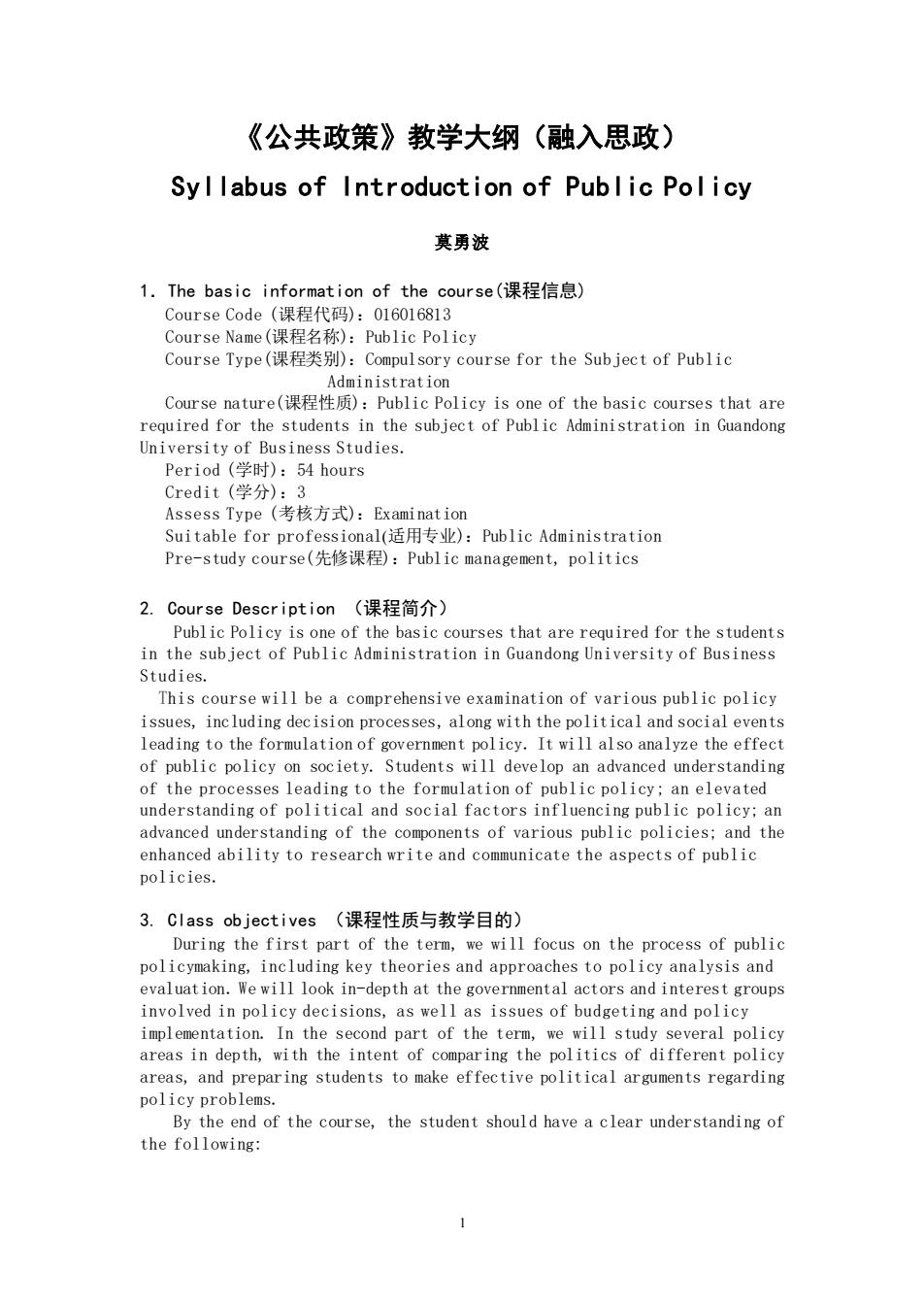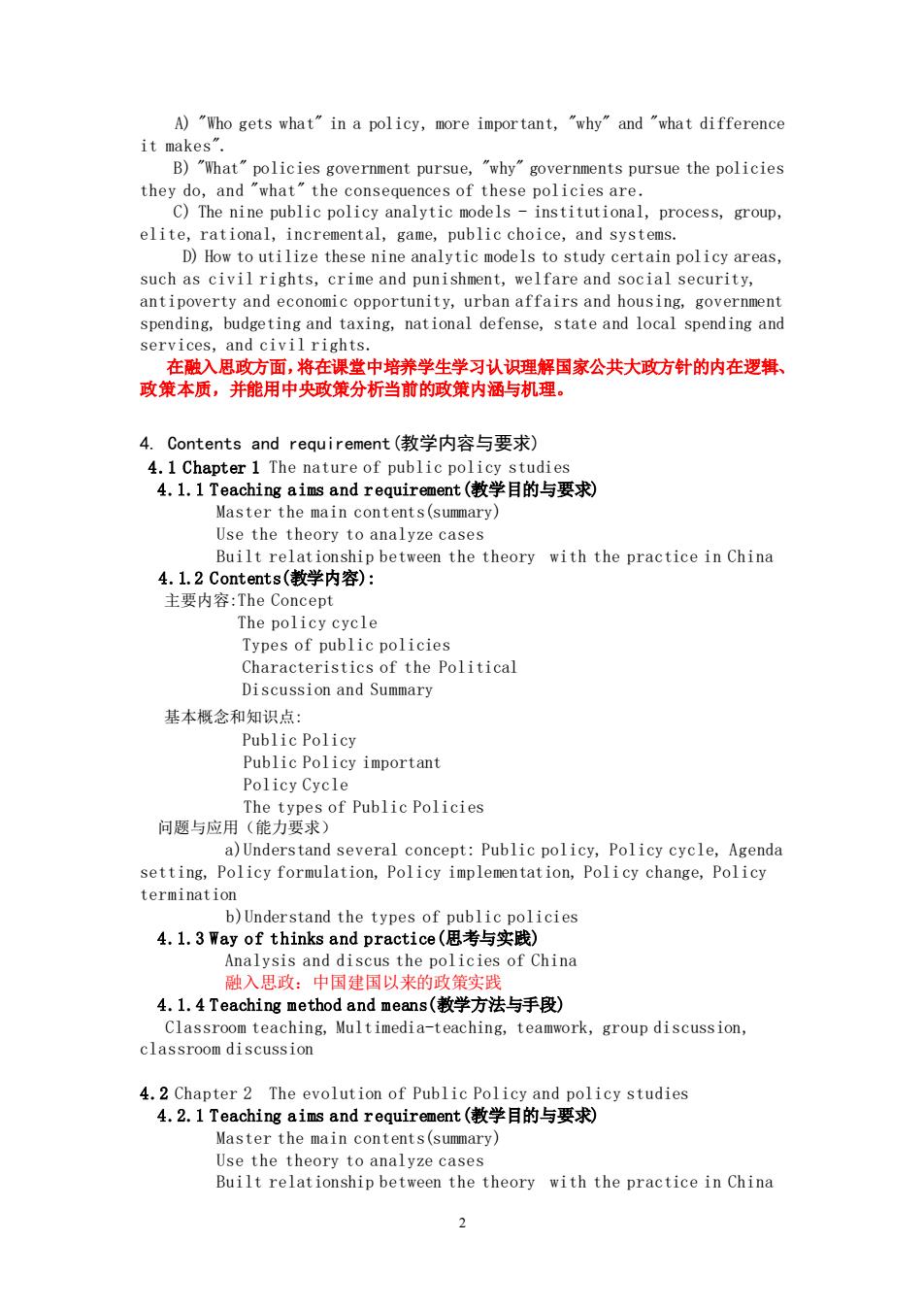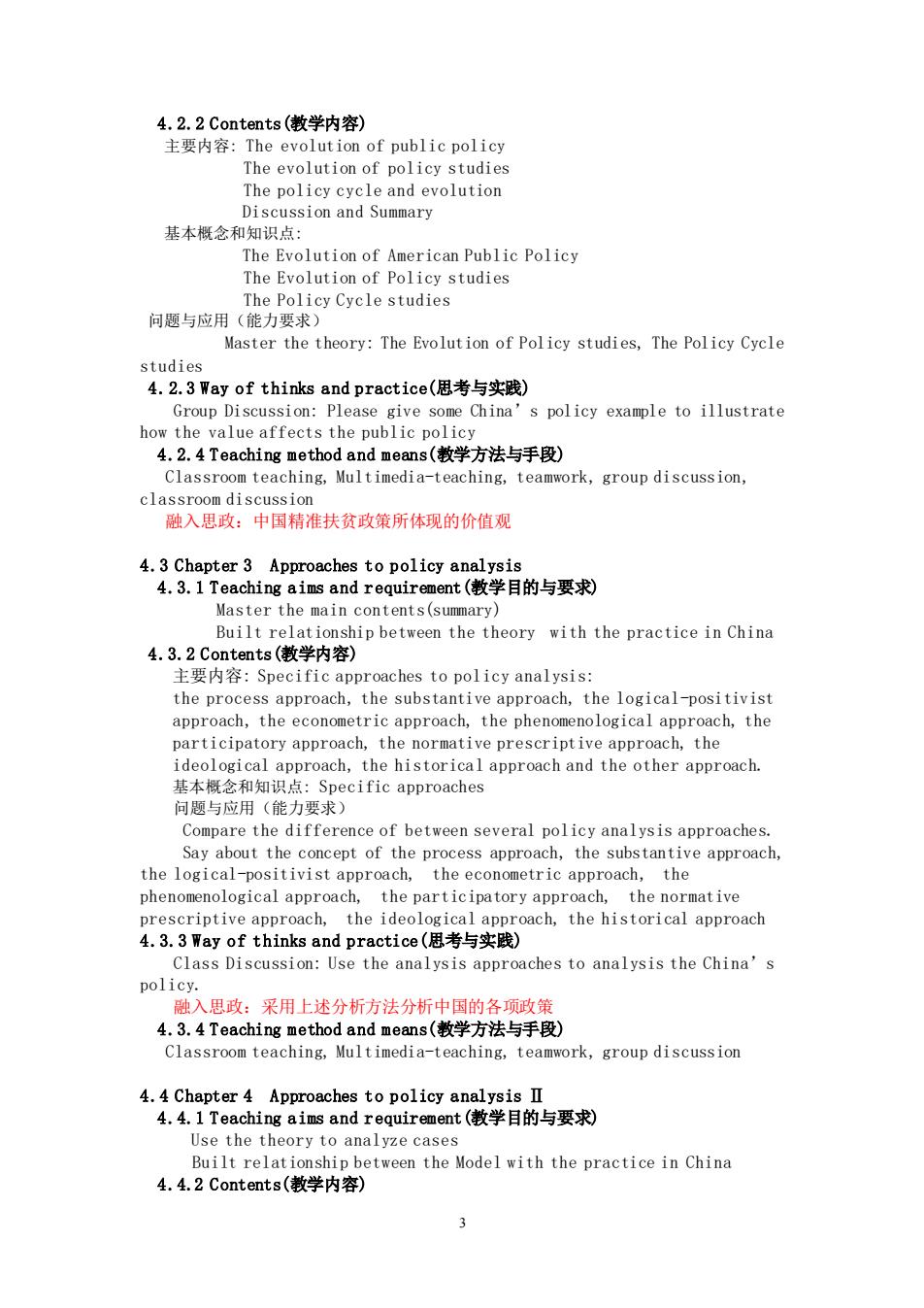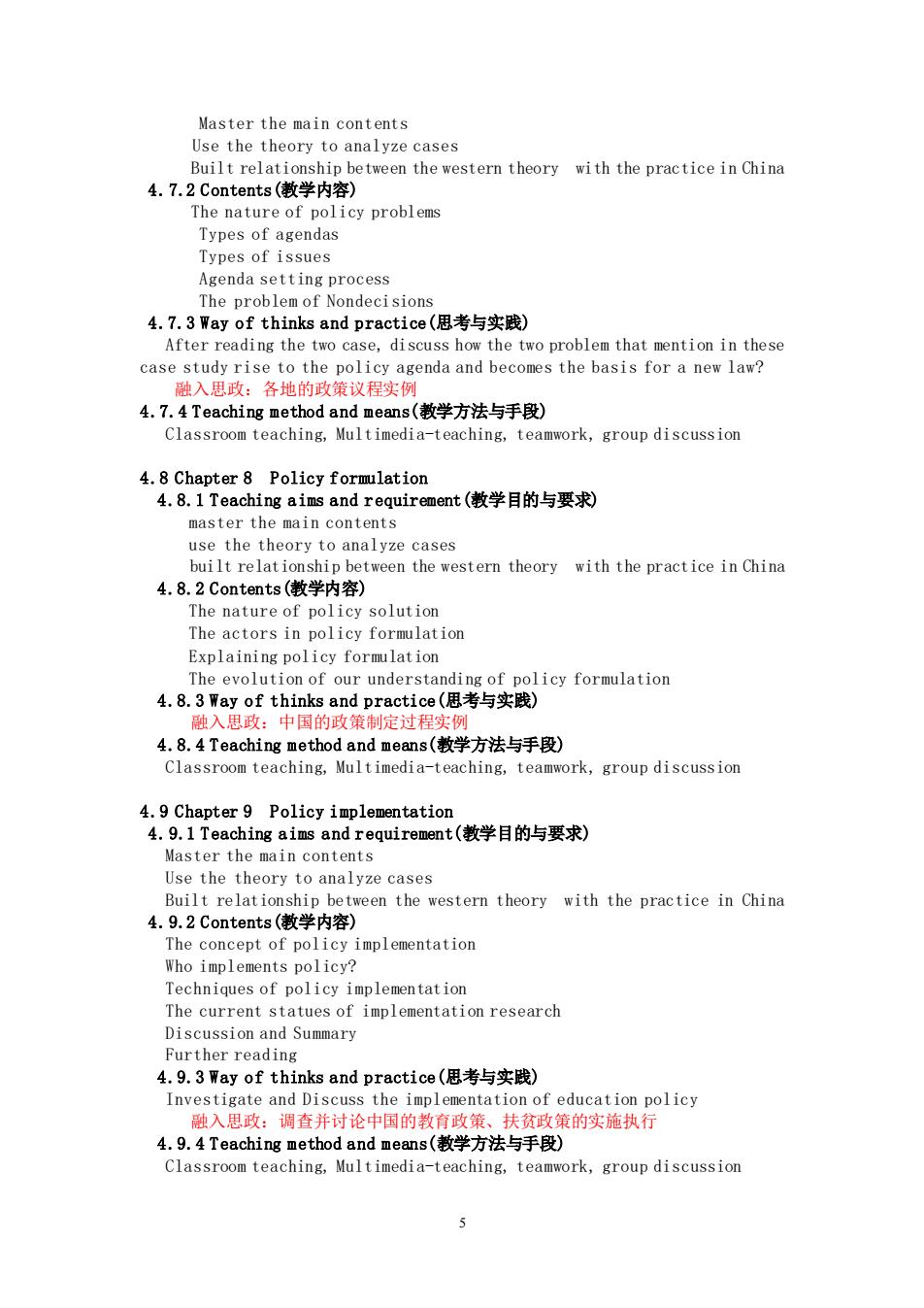
《公共政策》教学大纲(融入思政) Syl labus of Introduction of Public Policy 莫勇波 1.The basic information of the courset(课程信息) Course Code(课程代码):016016813 se Name(课程名称:Public Policy 8repe程:C 1c y course for the Subject of Public Period(学时):54 hours Credit(学分):3 Assess Type(考核方式):Examination Suitable for professional(适用专业):Public Administration Pre-study cose(先修课程:,politics 2.Course Description(课程简介) Public Policy is one of the basic courses that are required for the students in the subject of Public Administration in Guandong University of Business Studies. This course will be a comprehensive examination of various public policy issues,including decision processes,along with the political and social events leading to the formulation of government policy.It will also analyze the effect of public policy on society.Students will develop an advanced understanding of the processes leading to the formulation of public policy:an elevated understanding of political and social factors influencing public policy:an advanced understanding of the components of various public policies;and the enhanced ability to research write and communicate the aspects of public policies. 3.Class objectives(课程性质与教学目的) During the first part of the term,we will focus on the process of public policymaking,including key theories and approaches to policy analysis and evaluation.We will look in-depth at the governmental actors and interest groups involved in policy decisions,as well as issues of budgeting and policy implementation.In the second part of the term,we will study several policy areas in depth,with the intent of comparing the politics of different policy areas,and preparing students to make effective political arguments regarding policy problems. By the end of the course,the student should have a clear understanding of the following:
1 《公共政策》教学大纲(融入思政) Syllabus of Introduction of Public Policy 莫勇波 1.The basic information of the course(课程信息) Course Code (课程代码):016016813 Course Name(课程名称):Public Policy Course Type(课程类别):Compulsory course for the Subject of Public Administration Course nature(课程性质):Public Policy is one of the basic courses that are required for the students in the subject of Public Administration in Guandong University of Business Studies. Period (学时):54 hours Credit (学分):3 Assess Type (考核方式):Examination Suitable for professional(适用专业):Public Administration Pre-study course(先修课程):Public management, politics 2. Course Description (课程简介) Public Policy is one of the basic courses that are required for the students in the subject of Public Administration in Guandong University of Business Studies. This course will be a comprehensive examination of various public policy issues, including decision processes, along with the political and social events leading to the formulation of government policy. It will also analyze the effect of public policy on society. Students will develop an advanced understanding of the processes leading to the formulation of public policy; an elevated understanding of political and social factors influencing public policy; an advanced understanding of the components of various public policies; and the enhanced ability to research write and communicate the aspects of public policies. 3. Class objectives (课程性质与教学目的) During the first part of the term, we will focus on the process of public policymaking, including key theories and approaches to policy analysis and evaluation. We will look in-depth at the governmental actors and interest groups involved in policy decisions, as well as issues of budgeting and policy implementation. In the second part of the term, we will study several policy areas in depth, with the intent of comparing the politics of different policy areas, and preparing students to make effective political arguments regarding policy problems. By the end of the course, the student should have a clear understanding of the following:

A)"Who gets what"in a policy,more important,"why"and "what difference it makes". B)"What"policies government pursue,"why"governments pursue the policies they do,and "what"the consequences of these policies are. C)The nine public policy analytic models-institutional,process,group, elite,rational,incremental,game,public choice,and systems. D)How to utilize these nine analytic models to study certain policy areas, such as civil rights,crime and punishment,welfare and social security, antipoverty and economic opportunity,urban affairs and housing,government spending,budgeting and taxing,national defense,state and local spending and services,and civil rights. 在融入思政方面,将在课堂中培养学生学习认识理解国家公共大政方针的内在逻辑、 政策本质,并能用中央政策分析当前的政策内涵与机理。 4.Contents and requirement(教学内容与要求) 4.1 Chapter 1 The nature of public policy studies 4.l.1 Teaching aims and requirement(教学目的与要求) Master the main contents(summary) Use the theory to analyze cases Built relationship between the theory with the practice in China 4.1.2 Contents(教学内容): 主要内容:The Concept The policy cycle Types of public policies Characteristics of the Political Discussion and summary 基本概念和知识点: ublicPol cy important everal oncept:Public policy, setting,Policy formulation Policy cycle,Agenda Policy implementation,Policy change,Policy terminatio )Unde nd the type licies 4.1.3ma think pract 融入思政: 中国建国以来 4.1.4Teac ning method (教学 法与手段) tea ng,Multimedia-teaching,teamwork,group discussion classr 4.2 Chapter 2 The evolution of Public 4.2.1 ai an d require 学目的与 olicy studies t relati ze ca hin b tween the theory with the practice in China 2
2 A) "Who gets what" in a policy, more important, "why" and "what difference it makes". B) "What" policies government pursue, "why" governments pursue the policies they do, and "what" the consequences of these policies are. C) The nine public policy analytic models - institutional, process, group, elite, rational, incremental, game, public choice, and systems. D) How to utilize these nine analytic models to study certain policy areas, such as civil rights, crime and punishment, welfare and social security, antipoverty and economic opportunity, urban affairs and housing, government spending, budgeting and taxing, national defense, state and local spending and services, and civil rights. 在融入思政方面,将在课堂中培养学生学习认识理解国家公共大政方针的内在逻辑、 政策本质,并能用中央政策分析当前的政策内涵与机理。 4. Contents and requirement(教学内容与要求) 4.1 Chapter 1 The nature of public policy studies 4.1.1 Teaching aims and requirement(教学目的与要求) Master the main contents(summary) Use the theory to analyze cases Built relationship between the theory with the practice in China 4.1.2 Contents(教学内容): 主要内容:The Concept The policy cycle Types of public policies Characteristics of the Political Discussion and Summary 基本概念和知识点: Public Policy Public Policy important Policy Cycle The types of Public Policies 问题与应用(能力要求) a)Understand several concept: Public policy, Policy cycle, Agenda setting, Policy formulation, Policy implementation, Policy change, Policy termination b)Understand the types of public policies 4.1.3 Way of thinks and practice(思考与实践) Analysis and discus the policies of China 融入思政:中国建国以来的政策实践 4.1.4 Teaching method and means(教学方法与手段) Classroom teaching, Multimedia-teaching, teamwork, group discussion, classroom discussion 4.2 Chapter 2 The evolution of Public Policy and policy studies 4.2.1 Teaching aims and requirement(教学目的与要求) Master the main contents(summary) Use the theory to analyze cases Built relationship between the theory with the practice in China

4.2.2 Contents(教学内容) 主要内容:The evolution of public policy The evolution of nolicy studies The policy cycle and evolution Discussion and Summary 基本概念和知识点: The Evolution of American Public Policy The Evolution of Policy studies The Policy Cycle studies 问题与应用(能力要求) Master the theory:The Evolution of Policy studies,The Policy Cycle studies 4.2.3 Way of thinks and practice(思考与实践) Group Discussion:Please give some China's policy example to illustrate how the value affects the public policy 4.2.4 Teaching method and means(教学方法与手段) Classroom teaching,Multimedia-teaching,teamwork,group discussion, classroom discussion 融入思政:中国精准扶贫政策所体现的价值观 4.3 Chapter 3 Approaches to policy analysis 4.3.1 Teaching aims and requirement(教学目的与要求) Master the main contents(summary) Built relationship between the theory with the practice in China 4.3.2 Contents(教学纳容) 主要内容:Specific approaches to policy analysis: the process approach,the substantive approach,the logical-positivist approach,the econometric approach,the phenomenological approach,the participatory approach,the normative prescriptive approach,the ideological approach,the historical approach and the other approach. 基本概念和知识点:Specific approaches 问题与应用(能力要求) Compare the difference of between several policy analysis approaches. Say about the concept of the process approach,the substantive approach the logical-positivist approach,the econometric approach,the phenomenological approach,the participatory approach,the normative prescriptive approach,the ideological approach,the historical approach 4.3.3 Way of thinks and practice(思考与实贱) Class Discussion:Use the analysis approaches to analysis the China's polic 融入思政:采用上述分析方法分析中国的各项政第 4.3.4 Teaching method and means(教学方法与手段) Classroom teaching.Multimedia-teaching,teamwork,group discussion 4.4 Chapter 4 Approaches to policy analysisII 4.4.1 Teaching aims and requirement(徽学目的与要求) Use the theory to analyze cases Built relationship between the Model with the practice in China 4.4.2 Contents(教学内容)
3 4.2.2 Contents(教学内容) 主要内容: The evolution of public policy The evolution of policy studies The policy cycle and evolution Discussion and Summary 基本概念和知识点: The Evolution of American Public Policy The Evolution of Policy studies The Policy Cycle studies 问题与应用(能力要求) Master the theory: The Evolution of Policy studies, The Policy Cycle studies 4.2.3 Way of thinks and practice(思考与实践) Group Discussion: Please give some China’s policy example to illustrate how the value affects the public policy 4.2.4 Teaching method and means(教学方法与手段) Classroom teaching, Multimedia-teaching, teamwork, group discussion, classroom discussion 融入思政:中国精准扶贫政策所体现的价值观 4.3 Chapter 3 Approaches to policy analysis 4.3.1 Teaching aims and requirement(教学目的与要求) Master the main contents(summary) Built relationship between the theory with the practice in China 4.3.2 Contents(教学内容) 主要内容: Specific approaches to policy analysis: the process approach, the substantive approach, the logical-positivist approach, the econometric approach, the phenomenological approach, the participatory approach, the normative prescriptive approach, the ideological approach, the historical approach and the other approach. 基本概念和知识点: Specific approaches 问题与应用(能力要求) Compare the difference of between several policy analysis approaches. Say about the concept of the process approach, the substantive approach, the logical-positivist approach, the econometric approach, the phenomenological approach, the participatory approach, the normative prescriptive approach, the ideological approach, the historical approach 4.3.3 Way of thinks and practice(思考与实践) Class Discussion: Use the analysis approaches to analysis the China’s policy. 融入思政:采用上述分析方法分析中国的各项政策 4.3.4 Teaching method and means(教学方法与手段) Classroom teaching, Multimedia-teaching, teamwork, group discussion 4.4 Chapter 4 Approaches to policy analysis Ⅱ 4.4.1 Teaching aims and requirement(教学目的与要求) Use the theory to analyze cases Built relationship between the Model with the practice in China 4.4.2 Contents(教学内容)

Still other approaches Discussion and Summary further reading 4.4.3 Way of thinks and practice(思考与实践) Class Discussion:Use the analysis approaches to analysis the China's policy. 融入思政:采用上述分析方法分析中国的各项政策 4.4.4 Teaching method and means(教学方法与手段) Classroom teaching,Multimedia-teaching,teamwork,group discussion 4.5 Chapter 5 Models and public policy studies 4.5.1 Teaching aims and requirement(教学目的与要求) Master the main contents Use the Model to analyze cases Built relationship between the Model with the practice in China 4.5.2 Contents(教学纳容) The uses and forms of models Criteria for evaluating models Some examples of models Steps in building conceptual models Criteria for evaluating typologies Discussion and summary 4.5.3 Way of thinks and practice(思考与实践) The uses and forms of models Criteria for evaluating models Some examples of Models. Steps in building conceptual models 4.5.4 Teaching method and means(教学方法与手段) Classroom teaching,Multimedia-teaching,teamwork,group discussion 融入思政:用政策模型分析中国的各项政策 4.6 Chapter 6 Policy process 4.6.1 Teaching aims and requirement(傲学目的与要求) Master the main contents Built relationship between the theory with the practice in China 4.6.2 Contents(教学内容) The concept The policy process The affect factors Further reading 4.6.3 Way of thinks and practice(思考与实践) Discuss the China" s policy process 融入思政:学习并讨论中国的政策过程 4.6.4 Teaching method and means(教学方法与手段) Classroom teaching,Multimedia-teaching,teamwork,group discussion 4.7 Chapter 7 Agenda setting 4.7.1 Teaching aims and requirement(教学目的与要求)
4 Still other approaches Discussion and Summary Further reading 4.4.3 Way of thinks and practice(思考与实践) Class Discussion: Use the analysis approaches to analysis the China’s policy. 融入思政:采用上述分析方法分析中国的各项政策 4.4.4 Teaching method and means(教学方法与手段) Classroom teaching, Multimedia-teaching, teamwork, group discussion 4.5 Chapter 5 Models and public policy studies 4.5.1 Teaching aims and requirement(教学目的与要求) Master the main contents Use the Model to analyze cases Built relationship between the Model with the practice in China 4.5.2 Contents(教学内容) The uses and forms of models Criteria for evaluating models Some examples of models Steps in building conceptual models Criteria for evaluating typologies Discussion and Summary 4.5.3 Way of thinks and practice(思考与实践) The uses and forms of models. Criteria for evaluating models. Some examples of Models. Steps in building conceptual models. 4.5.4 Teaching method and means(教学方法与手段) Classroom teaching, Multimedia-teaching, teamwork, group discussion 融入思政:用政策模型分析中国的各项政策 4.6 Chapter 6 Policy process 4.6.1 Teaching aims and requirement(教学目的与要求) Master the main contents Built relationship between the theory with the practice in China 4.6.2 Contents(教学内容) The concept The policy process The affect factors Further reading 4.6.3 Way of thinks and practice(思考与实践) Discuss the China’s policy process 融入思政:学习并讨论中国的政策过程 4.6.4 Teaching method and means(教学方法与手段) Classroom teaching, Multimedia-teaching, teamwork, group discussion 4.7 Chapter 7 Agenda setting 4.7.1 Teaching aims and requirement(教学目的与要求)

Master the main contents Use the theory to analyze cases Built relationship between the western theory with the practice in China 4.7.2 Contents(教学内容) The nature of policy problems Types of agendas Types of issues Agenda setting process The problem of Nondeci sions 4.7.3 Way of thinks and practice(思考与实践) After reading the two case,discuss how the two problem that mention in these case study rise to the policy agenda and becomes the basis for a new law? 融入因政:各地的政箭议程实例 4.7.4 Teaching method and means(教学方法与手段) Classroom teaching.Multimedia-teaching,teamwork.group discussion 4.8 Chapter 8 Policy formulation 4.8.1 Teaching aims and requirement(教学目的与要求) master the main contents use the theory to analyze cases built relationship between the western theory with the practice in China 4.8.2 Contents(教学内容) The nature of policy solution The actors in policy formulation Explaining policy formulation The evolution of our understanding of policy formulation 4.8.3 Way of thinks and practice(思考与实践) 融入思改:中闲的政笛制定讨程实例 4.8.4 Teaching method and means(教学方法与手段) Classroom teaching,Multimedia-teaching,teamwork,group discussion 4.9 Chapter 9 Policy implementation 4.9.1 Teaching aims and requirement(学目的与要求) Master the main contents Use the theory to analyze cases Built relationship between the western theory with the practice in China 4.9.2 Contents(教学内容) The concept of policy implementation Who implements policy? Techniques of policy implementation The current statues of implementation research Discussion and Summary Further reading 4.9.3 Way of thinks and practice(思考与实践) Investigate and Discuss the implementation of education policy 融入思政:调查并讨论中国的教育政策、扶贫政策的实施执行 4.9.4 Teaching method and means(敦学方法与手段) Classroom teaching.Multimedia-teaching.teamwork,group discussion 5
5 Master the main contents Use the theory to analyze cases Built relationship between the western theory with the practice in China 4.7.2 Contents(教学内容) The nature of policy problems Types of agendas Types of issues Agenda setting process The problem of Nondecisions 4.7.3 Way of thinks and practice(思考与实践) After reading the two case, discuss how the two problem that mention in these case study rise to the policy agenda and becomes the basis for a new law? 融入思政:各地的政策议程实例 4.7.4 Teaching method and means(教学方法与手段) Classroom teaching, Multimedia-teaching, teamwork, group discussion 4.8 Chapter 8 Policy formulation 4.8.1 Teaching aims and requirement(教学目的与要求) master the main contents use the theory to analyze cases built relationship between the western theory with the practice in China 4.8.2 Contents(教学内容) The nature of policy solution The actors in policy formulation Explaining policy formulation The evolution of our understanding of policy formulation 4.8.3 Way of thinks and practice(思考与实践) 融入思政:中国的政策制定过程实例 4.8.4 Teaching method and means(教学方法与手段) Classroom teaching, Multimedia-teaching, teamwork, group discussion 4 .9 Chapter 9 Policy implementation 4 .9.1 Teaching aims and requirement(教学目的与要求) Master the main contents Use the theory to analyze cases Built relationship between the western theory with the practice in China 4.9.2 Contents(教学内容) The concept of policy implementation Who implements policy? Techniques of policy implementation The current statues of implementation research Discussion and Summary Further reading 4.9.3 Way of thinks and practice(思考与实践) Investigate and Discuss the implementation of education policy 融入思政:调查并讨论中国的教育政策、扶贫政策的实施执行 4.9.4 Teaching method and means(教学方法与手段) Classroom teaching, Multimedia-teaching, teamwork, group discussion